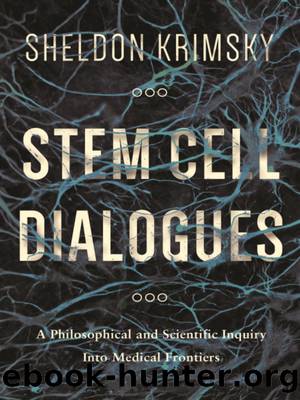Stem Cell Dialogues by Sheldon Krimsky

Author:Sheldon Krimsky
Language: eng
Format: epub
Tags: SCI075000, Science/Philosophy and Social Aspects, PHI005000, Philosophy/Ethics and Moral Philosophy
Publisher: Columbia University Press
Published: 2015-06-22T16:00:00+00:00
DIALOGUE 18
HUMAN-ANIMAL CHIMERAS AND HYBRIDS
The word “chimera” is derived from Greek mythology. The “Chimaira” was depicted as a fire-breathing female creature of ancient Lycia composed of parts of three animals: a lion, a goat, and a snake. The term has come to mean any mythological creature that is a composite of two or more animals. The earliest literary reference to a chimera is found in Homer’s Iliad, where it is described as “a thing of immortal make, not human, lion fronted and snake behind, a goat in the middle, and snorting out the breath of the terrible flame of bright fire.”1
In modern biology, a chimera is an organism composed of cells from different zygotes (fertilized eggs or early embryos) that have been fused. The resulting organism has a mixture of tissue with cells from at least two sources of nuclear DNA. Human chimeras can arise naturally during pregnancy. Two fertilized eggs in a woman’s womb that spontaneously fuse during early gestation will grow to term as a chimera. Also, when two embryos are in the womb and cells from one embryo migrate to and are absorbed by the other, the result is a chimeric child. The chimeric child’s organs have different sets of chromosomes: skin cells, kidney cells, and blood cells may not have identical nuclear DNA.
In maternity testing there are cases where a biological chimeric mother’s DNA does not match that of her biological child when cells taken from certain parts of her body are compared to her child’s cells. Forensic DNA testing can result in false negatives when comparing different cells of the same chimeric individual.
People go through life not knowing that they are chimeras. There are no dependable estimates of how many human chimeras are born each year. The rate of natural fraternal embryo fusion is not well documented.
Chimeras are distinguished from transgenic animals or hybrids, in which one or more foreign genes is added to an animal’s single set of chromosomes. Chimeras have two sets of chromosomes in various tissues in their body.
Artificial chimeras can be created when scientists fuse two zygotes of the same species (intraspecies) or two zygotes from different species (interspecies). Some women with mitochondrial disease who wish to have a biological child have turned their eggs into mitochondrial chimeras. Their eggs with mutated mitochondrial cells are infused with healthy mitochondria from the cytoplasm of a donated egg, resulting in an egg with mitochondrial cells from two genomes, called heteroplasmy.
In 1953 the British Medical Journal reported a woman with blood containing two different blood types. A rare case of chimerism called tetragametic chimerism occurs through the fertilization of two eggs by two spermatozoa, followed by the fusion of the zygotes; the resulting child has intermingled cells from two distinct genomes.2
Chimeras can be artificially produced in research by transplanting embryonic cells from one organism onto the embryo of another, as in injecting mouse stem cells into mouse blastocysts. A chimera called a “geep” was produced in 1984 by combining embryos from a goat and a sheep.
Download
This site does not store any files on its server. We only index and link to content provided by other sites. Please contact the content providers to delete copyright contents if any and email us, we'll remove relevant links or contents immediately.
| Administration & Medicine Economics | Allied Health Professions |
| Basic Sciences | Dentistry |
| History | Medical Informatics |
| Medicine | Nursing |
| Pharmacology | Psychology |
| Research | Veterinary Medicine |
Periodization Training for Sports by Tudor Bompa(8209)
Why We Sleep: Unlocking the Power of Sleep and Dreams by Matthew Walker(6651)
Paper Towns by Green John(5136)
The Immortal Life of Henrietta Lacks by Rebecca Skloot(4548)
The Sports Rules Book by Human Kinetics(4339)
Dynamic Alignment Through Imagery by Eric Franklin(4173)
ACSM's Complete Guide to Fitness & Health by ACSM(4019)
Kaplan MCAT Organic Chemistry Review: Created for MCAT 2015 (Kaplan Test Prep) by Kaplan(3969)
Introduction to Kinesiology by Shirl J. Hoffman(3743)
Livewired by David Eagleman(3728)
The Death of the Heart by Elizabeth Bowen(3577)
The River of Consciousness by Oliver Sacks(3571)
Alchemy and Alchemists by C. J. S. Thompson(3480)
Bad Pharma by Ben Goldacre(3395)
Descartes' Error by Antonio Damasio(3247)
The Emperor of All Maladies: A Biography of Cancer by Siddhartha Mukherjee(3111)
The Gene: An Intimate History by Siddhartha Mukherjee(3074)
The Fate of Rome: Climate, Disease, and the End of an Empire (The Princeton History of the Ancient World) by Kyle Harper(3030)
Kaplan MCAT Behavioral Sciences Review: Created for MCAT 2015 (Kaplan Test Prep) by Kaplan(2957)
